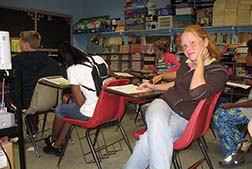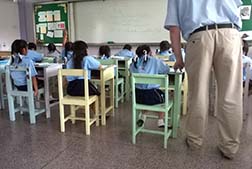Assessment
 School Climate Assessment
School Climate Assessment
The Resiliency School Climate Assessment method is an efficient process for evaluation of school climate and guiding change. The assessment focuses on measuring factors that are accurate indicators of school climate based on research and science. A school climate assessment is designed to identify school strengths, weaknesses, systemic issues, and pervasive values that impact school climate. The assessment consists of a school-wide survey; administrator, teacher, staff, student, and parent interviews; and school day observations. This is an intensive process consisting of days of observations and interviews, and extensive hours of data compilation in order to analyze trends and patterns per each school. The report provides the school with not only sound data but also with recommendations from which systems change can be designed.
No identifying information is taken when conducting interviews or provided in the written report. Thus, school staff, students, and parents feel free to provide vital information that contributes to an accurate assessment of the school’s climate and performance.
In two days they were able to identify issues that we have been attempting to assess for years and then provided a concrete plan of corrective action.
Fran Rodenburg, Assistant Superintendent
Bismarck Public Schools
 Student Assessment
Student Assessment
The Brief Resiliency Checklist (BRC) is an effective way of focusing schools on the strengths and weaknesses that each student possesses that impact school success. Since the factors identified in the BRC apply across race, culture, and sex, it enables educators to become familiar with the specific measures that cause academic and behavioral issues. The shift from disability, race, and socio-economics to holistic factors that apply to every individual is a very effective method to conduct early identification and reduce over-identification. Once educators learn to identify strengths and know-how these protective factors mitigate against the presence of risk, it will increase their resolve to continue working with certain students even in light of their presenting risks.
- The BRC provides a student profile immediately upon completion of an assessment that identifies a student’s behavioral patterns, strengths, and presenting risk factors.
- Each assessment provides a student profile. The student profile provides schools with concrete recommendations that include the following: preferred educational setting for the student, the length and duration recommended for an intervention, recommended educational services, and even a specific initial plan to help teachers begin to effectively work with the student the next day.
- The BRC also offers educational agencies the opportunity to analyze their data in order to identify their needs and determine an effective course of action.
- Since the BRC identifies factors that are predictive of educational outcomes, it provides educational agencies with valid indicators to analyze outcomes.
- Participating educational agencies become members of a large databank of information at their disposal to continue finding exciting new trends and outcomes.
